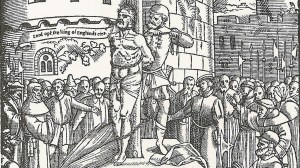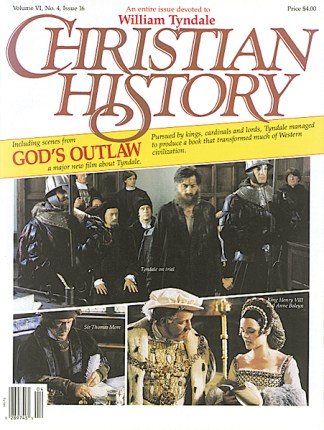In this series
As much as English-speaking and reading Christians should consider themselves indebted to Tyndale, they should consider themselves equally indebted to Johannes Gutenberg—without him, Tyndale’s “revolution” might well have been almost inconsequential.
Of course Gutenberg was not the first man ever to have thought of or used movable, mechanical type for duplicating documents; Chinese and Korean printers had developed and begun using some forms of movable type as early as 1060 A.D.
But if Gutenberg—or someone like him—hadn’t designed and built the first commercially effective printing facility ever, in Mainz, Germany in 1450, then Tyndale would have had to publish his translation of the New Testament into English by means of hiring scribes to copy it by hand. And even the fastest of scribes could not have produced in one year the number of copies of the New Testament that a Gutenberg-like press could produce in just a few weeks.
Without Gutenberg, production and distribution of Tyndale’s translation would have been severely slowed down by merely technical problems, not to mention all the resistance Tyndale received from official Roman Catholic and government sources.
But because Gutenberg devised the means to print a Latin version of the Bible with movable type in an original edition of 150 copies on heavy paper, plus 30 on fine vellum, Tyndale was able to print thousands of copies of an English version of the Bible on regular paper, and get them distributed all across his native England. And while we are certainly indebted to Tyndale for his steadfastness against the official resistance, both we and Tyndale are indebted to Gutenberg for his steadfastness against resistance of a different sort.
It is difficult to piece together the details of Gutenberg’s early life, but it is not hard to imagine this son of a scribe spending his days watching his father at work, and anguishing. The scribe’s job saw him bent over his writing table for hours on end, sometimes in minimal light, with infinite pains copying long and intricate manuscripts over and over again for the nobility, clergy and lawyers—and all by hand. A single book could take months to copy, and then it might start all over again.
So Johannes apparently watched his father, and thought, and came to a paradoxical resolution. While he appreciated the beauty and craft of his father’s handiwork—the intricately illustrated initial letters and the carefully aligned rows of graceful text—he was also moved with compassion over the drudgery of his father’s work and determined to do something to bypass the excruciating slowness of the process. He was inspired by the majesty of the craftsman’s finished product, a book, but was somehow more inspired with the idea that he could by some means produce hundreds of beautiful pages in the time his father produced one. And without the errors and deviations from copy to copy that always appeared in scribes’ work, even his father’s, no matter how painstaking they might be.
But first he had to encounter the resistance, which would wrestle with him throughout his life and finally beat him at the end: the resistance of financial shortages, legal manipulators and industrial self-protection.
In 1428, the Gutenberg family had to move from Mainz (Johannes’ boyhood home) to Strasbourg. It seems the trade guilds of Mainz succeeded in ousting the patricians, of whom the Gutenbergs were members. Today we would call this “unionism-out-of-control.” By this time, the 28-year-old Johannes had already sunk large portions of his personal finances into printing experiments, and was looking for funds from others.
He continued this in Strasbourg, but finding lenders’ capital in a new city was even more difficult than in Mainz. So in 1444 he returned to Mainz and continued experimenting, despite skepticism and resistance from the scribes’ guilds. They didn’t like the thought of losing their jobs, and so spread rumors that he was an alchemist working on “devilish” things in his shop. But he did nothing to quell such rumors—in fact his working behind drawn shades probably only aggravated them. Rather, he simply rededicated himself to his experiments, resolving that he would work until the books he produced were not only uniform in appearance but distinctly more beautiful than those produced by the scribes.
In his drive toward perfection, he devised several techniques that remained fundamental to the printing industry until only recently, when photo-processing and computerization came along. Out of steel, he cut each letter of the alphabet, both capitals and lowercase, in order to make raised stamps that could be pounded into blocks of copper to form molds. He dropped these into a hand-casting device that was closed and filled with soft alloy to make one distinctive piece of type. These characters, lined up in columns, were held tight by locking them into a “forme” of wood, which was broken down after each page was printed for use on another page.
After four years of experimenting with such techniques, and no noticeable profit in sight, Gutenberg’s finances had dwindled to the point that he had to borrow some money from a relative—a small loan of only 150 guilders. But one year after that, in 1449, with his progress still only measurable in terms of how much deeper he was in debt, he decided to approach Johann Fust, a wealthy Mainz lawyer, and ask him for 800 guilders at six percent interest. As security, he pledged his entire printing apparatus. Fust gave him the loan, and Gutenberg began printing pamphlets, leaflets and indulgences as quickly as he could.
Finally, enough experimenting, and Gutenberg was ready to print his first book. And what book would it be? The Bible, of course. What other work was worthy of man’s best efforts? Which Bible? The Latin Vulgate, of course, the only Bible a good Catholic like Gutenberg would have acknowledged. In fact, printing the Latin Bible had been his goal for a very long time. But he had never imagined how much it would actually prove to cost him.
He wanted to produce 188 copies of the Bible, and he needed a huge sum of money to purchase the 8,000 calf skins and 100,000 sheets of paper that would be necessary. So he went back to Fust. The wealthy lawyer shrewdly sensed Gutenberg’s precarious financial position, and also the tremendous profits to be made from the new printing process. So he gladly loaned another 800 guilders to Gutenberg, on the condition that he be made a partner and glean a share of the profits. Gutenberg agreed, and in 1452 the first Bible began production; a whole new basis for human communication was established; and profits rolled in.
But only three years later, in 1455, the cagey Fust sued Gutenberg and, with the help of the print shop’s foreman, completely took over the operation. Gutenberg retained no interest, and after finally acquiring a minor job with the Archbishop of Mainz, he died in 1468, a poor and broken-hearted man.
Little did he imagine that less than 80 years later, presses based on his design would be funneling thousands of copies of Luther’s and Tyndale’s “common language,” “Protestant” Bibles into the hands of German and English commoners, thus fueling the Reformation’s fires and helping bring an end to the Dark Ages. Nor could he have imagined that some 500 years later one of the first copies of his Latin Bible would be purchased by the University of Texas for $2.4 million—a substantial increase over the tiny amount he charged for one, and a price that clearly acknowledges the enormity of what he did for man by making it possible to duplicate and distribute information more rapidly.
So what Tyndale and we owe Gutenberg includes his refinement of moving type and inks, his refinement of the printing press, and his opening the way so that book distribution among the common people became a more-common thing.
His genius literally placed millions of books in the hands, and ideas in the minds, of people all around the world—enormously multiplying our knowledge and the rate at which it has increased. But perhaps a greater gift, from a spiritual angle, is that his inventions helped us to easily gain access to God’s Word in our own language.
Raymond A. LaJoie is a veteran free-lance writer, with more than 3,000 published articles and several writing awards to his credit. He lives in Worcester, Mass
Copyright © 1987 by the author or Christianity Today/Christian History magazine. Click here for reprint information on Christian History.












